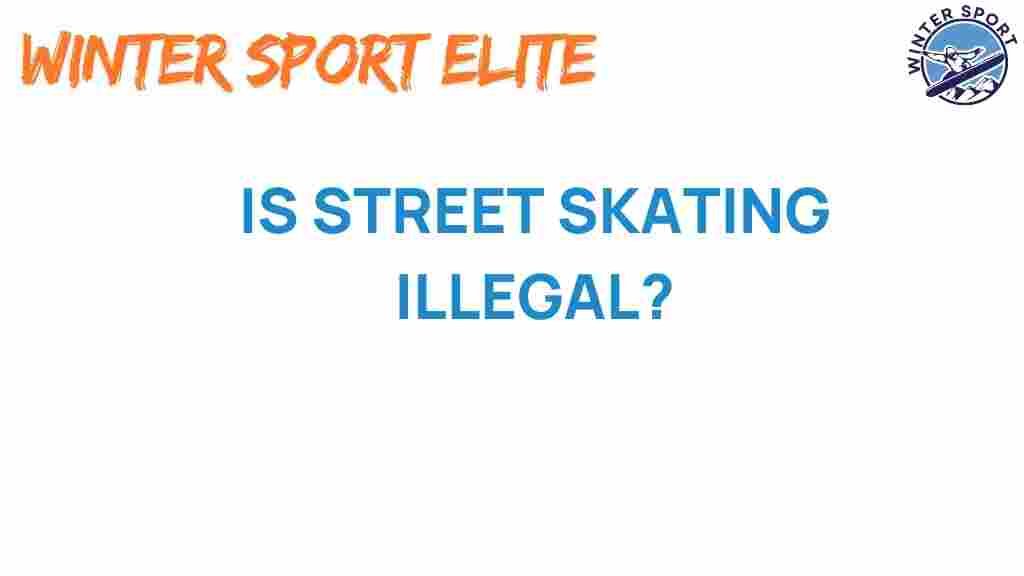Is Street Skating Illegal? Unpacking the Rules and Risks
Street skating has become a vibrant and essential part of urban culture, attracting enthusiasts who express themselves through creativity and athleticism. However, many skaters wonder: is street skating illegal? The answer is nuanced and varies by location, as it involves different skateboarding laws, regulations, and public spaces. In this article, we will unpack the legality of urban skating, explore skater rights, and outline potential legal risks associated with street skating.
Understanding the Legality of Street Skating
The legality of street skating largely depends on local laws and regulations. Here’s what you need to know:
- Public vs. Private Property: Street skating is generally allowed in public spaces, but skating on private property without permission is considered trespassing.
- Local Ordinances: Many cities have specific city regulations governing skateboarding. These can include designated skate parks and restrictions in certain areas.
- Safety Regulations: Some regions require safety gear, like helmets, for younger skaters. Non-compliance can lead to fines.
Common Misconceptions about Street Skating Legality
There are several misconceptions surrounding the legality of street skating:
- All Public Spaces Are Skate-Friendly: Just because an area is public doesn’t mean it’s legal to skate there. Always check local laws.
- Skaters Have No Rights: Skaters have rights, but they must know and respect local regulations to avoid conflicts.
- Police Will Always Enforce the Law: In many cases, law enforcement may prioritize safety and community relations over strict enforcement of skateboarding laws.
Key Factors Influencing Street Skating Legality
When considering the legality of street skating, several factors come into play:
1. Local Laws and Regulations
Different cities have varying laws regarding skateboarding in public spaces. Some may encourage skating by providing designated areas, while others may impose strict regulations. Familiarizing yourself with your city’s skateboarding laws is crucial.
2. Type of Public Space
Skating in parks, plazas, and streets may be treated differently. For instance:
- Parks: Many parks are designated for recreational activities, including skateboarding. However, some parks may have restrictions on certain types of skating.
- Sidewalks: Skating on sidewalks is generally allowed, but be mindful of pedestrians and local regulations.
- Streets: Street skating may be illegal in certain busy areas, especially if it poses a risk to public safety.
3. Community Attitudes
The community’s perception of skating can influence the enforcement of laws. In areas where skating is embraced, skaters might face fewer legal challenges. Conversely, in communities that view skating as a nuisance, skaters may face strict enforcement.
Legal Risks Associated with Street Skating
While street skating can be an exhilarating activity, it comes with certain legal risks:
1. Trespassing Charges
Skating on private property without permission can lead to trespassing charges. Always seek permission before skating in private areas.
2. Fines and Citations
Many cities impose fines for violating skateboarding laws. These fines can vary significantly, so it’s essential to be aware of local regulations.
3. Injuries and Liability
If you injure yourself while skating in a prohibited area, you may not be able to seek compensation for medical expenses. Understanding the risks involved is crucial.
Step-by-Step Process to Ensure Legal Street Skating
To enjoy street skating while minimizing legal risks, follow these steps:
Step 1: Research Local Laws
Before hitting the streets, research your local laws regarding skating in public spaces. Websites, community boards, and local skate shops can be valuable resources.
Step 2: Identify Skate-Friendly Areas
Look for designated skate parks or areas where skating is expressly permitted. These are safe options for skaters.
Step 3: Obtain Permission for Private Property
If you wish to skate on private property, always seek permission from the property owner. This can help you avoid legal troubles.
Step 4: Follow Safety Guidelines
Wear appropriate safety gear and adhere to any local safety regulations. This not only protects you but also shows respect for the community.
Step 5: Be Respectful of Your Environment
Keep noise levels down, be courteous to pedestrians, and avoid damaging property. This fosters goodwill and can help improve community attitudes toward skaters.
Troubleshooting Tips for Skaters
Even with proper knowledge, skaters may find themselves in tricky situations. Here are some troubleshooting tips:
1. What to Do if Confronted by Authorities
If approached by law enforcement or property owners:
- Stay calm and respectful.
- Be aware of your rights; you can ask if you’re being detained.
- If asked to leave, do so politely without argument.
2. How to Handle Community Backlash
If you encounter negative attitudes from community members:
- Engage in open dialogue to understand their concerns.
- Consider organizing community events to promote positive interactions.
- Showcase your skills in designated areas to gain public support.
3. Finding Legal Representation
If you face legal challenges, consider seeking legal advice. Organizations that support skater rights, like the Skateboard Advocacy Coalition, can provide resources and guidance.
Conclusion
While street skating is a beloved aspect of urban culture, its legality can vary significantly depending on location and local regulations. By understanding the laws, respecting public spaces, and advocating for your rights as a skater, you can enjoy the thrill of street skating while minimizing legal risks. Always stay informed and engaged with your community to foster a positive environment for all skaters.
For more information on skateboarding laws and community initiatives, check out this helpful resource.
This article is in the category Events and created by WinterSportElite Team
